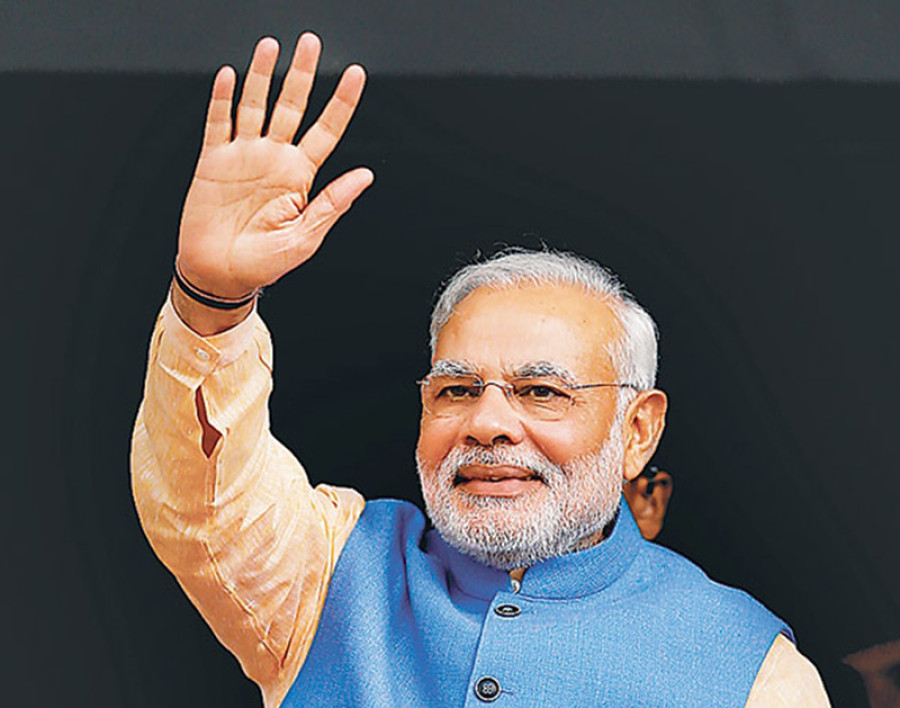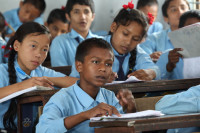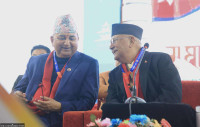Opinion
A saffron Holi
Despite challenges, Narendra Modi’s opponents are running out of ideas (and time) to stop him from coming back to power next year
Amish Raj Mulmi
A barb that does the rounds on Indian Twitter every time the BJP finds itself in a fix with a new corruption scam or a shady defence deal is that the party is nothing but ‘Congress plus the Cow’. When the news of diamond jeweller NiravModi’s massive $2 billion fraud at the government-owned Punjab National Bank hit the news, anti-BJP-wallahs had begun licking their lips. Here was a government that had promised to sweep out corruption, and yet, the man at the centre of the scam was seen in pictures with Prime Minister Narendra Modi at the World Economic Forum in Davos. It was a readymade political weapon to shatter Modi’s anti-corruption message.
And yet, by the time the results of the three North-East state elections were out over the weekend, the NiravModi (or #NiMo, as the Twitter hashtag goes, harkening back to the original #NaMo) scandal had been relegated to second lede. For, the BJP’s victories in the three states will reaffirm what’s been going on in everyone’s minds: NarendraModimay very well come back to power in next year’s general elections.
It is not as if the #NiMo scandal has had no effect on the government,but the Indian prime minister has beena shrewd and tactical politician from the very beginning. When the Congress hit out at him for wearing a suit embossed with his name, calling his government a ‘suit-boot kisarkar’, NarendraModi began to make a conscious effort to stay away from big business events, and his government’s last budget made its rural push quite apparent. Now, when the #NiMo fraud was threatening to derail the anti-corruption message, the Modi government approved a new bill targeting economic offenders like #NiMo and Vijay Mallya who have fled the country, and created a new body to regulate auditors and chartered accountants. India also issued a non-bailable warrant against the diamond jeweller, his partner MehulChoksi, and several others connected to the scam, and has arrested others. And for good measure, the investigating agency, India’s Central Bureau of Investigation(CBI),arrested Congress leader P Chidambaram’s son Karti Chidambaram after new allegations of impropriety emerged in an ongoing money laundering case.
As Indian news channels went into overdrive asking whether Karti’s arrest was politically motivated to sideline the attention on #NiMo, one thing was clear. Narendra Modi had, once again, seized the narrative and shaped it to his advantage. And now, with the results of the recent state elections, his political opponents are running out of timeto counter his re-election in 2019.
The Lotus rises
The BJP did not register a massive victory in either of the three North-eastern states of Nagaland, Meghalaya and Tripura. In Nagaland, it won 12 seats, but its ally the Nationalist Democratic Progressive Party (NDPP) won 16 seats. With 32 seats in total (including a few smaller outfits supporting the alliance), the BJP-NDPP will now form the government. In Meghalaya, the Congress emerged as the largest party with 21 seats. The BJP won only two seats, but it is now in government, with the second-largest party, the National People’s Party, forming a five-party alliance with the BJP and others to stop the Congress from staking its claim.
However, in Tripura, the BJP won, to quote Donald Trump, ‘bigly’. It won 35 seats in the 60-member House, and with its ally the Indigenous People’s Front of Tripura (IPFT), it holds 43 seats. The Communist Party of India (Marxist), which had ruled the state since 1998, saw the number of its seats drop from 50 to 16. The Congress—well—was decimated. It held10 seats in the previous House, and now holds none.
The Tripura verdict stands out for several reasons. The BJP is now India’s only national party, with 70 percent of the population living in states ruled by it or its allies. Its victory—as a result of a coalition or otherwise—in the North-East means it is no longer a ‘north Indian’ party. In rising from a meagre two seats and 1.5 percent vote share in the previous election to 35 seats and a 43 percent vote share, its organisational efficacy and outreach programmes have once again proved to be one of India’s ‘greatest election machines’. In Tripura, despite the Left government’s success in defeating the insurgency and ex-chief minister ManikSarkar’s own popularity, the BJP hit out at the lack of development and economic opportunities in the state, and claimed the anti-Left space from the Congress. One can also choose to view the victory from the BJP-RSS objective of eliminating the Communist ideal from Indian politics, with the news of BJP supporters toppling a Lenin statue being accompanied by reports of violence against Communist workers post elections.
Running out of time
There are challenges, however. On Thursday, the cracks within the BJP-led National Democratic Alliance (NDA) were out in the open. Telugu Desam, one of the parties in the NDA, decided to withdraw its ministers from the Union government after a rift over granting Andhra Pradesh, which bifurcated into two states, more funds. In UP, ex-rivals Mayawati and Mulayam Singh Yadav have come together to fight two LokSabha by-polls. But as a report suggested, the BJP is ready to offset any losses in seats with its new gains in the North-East. MamataBanerjee is also reportedly backing a ‘Third Front’ for the 2019 elections, which seeks to be a pan-Indian alliance of parties without the Congress or the BJP. And Sonia Gandhi’s March 13 dinner invitation to opposition leaders may yet see a new anti-BJP alliance shaping up.
If a cohesive opposition to the BJP is to arise, it needs to not only overcome personal egos and ideological differences, but also the organisational clout of the BJP. In Tripura, for example, the BJP reached out to voters for over two years, backed by the RSS’s cadres—similar to what it had done in UP last year. And although the Congress once had the organisational skills to match the BJP, it has been grasping at straws recently. Victories in by-elections and its solid showing in the Gujarat elections had made the party optimistic, but it’s increasingly clear the present-day Congress is now a pale imitation of the behemoth it once was. The party’s counter to the BJP on the latter’s majoritarian vision remains poorly defined, while Rahul Gandhi’s leadership continues to dazzle momentarily, only to fizzle out when election day comes.
In electoral politics, perception matters as much as reality. With the #NiMo scam, the BJP only had to dig out the old ghosts of Karti Chidambaram to put the Congress on the backfoot. The Indian economy is going through a phase of ‘jobless growth’, and farmers’ protests continue over the prevailing agricultural distress, but the opposition has failed to take this message to the voter. And while there have been moments in the past where a united opposition has taken on a party’s monopoly in India, it’s too early to say whether these reports of a ‘Third Front’ will make a dent on the BJP’s pan-Indian ambitions. In the lack of any credible alternative, the BJP and Narendra Modi’s return to the Centre in next year’s elections could be more than just a likelihood.




 13.12°C Kathmandu
13.12°C Kathmandu










